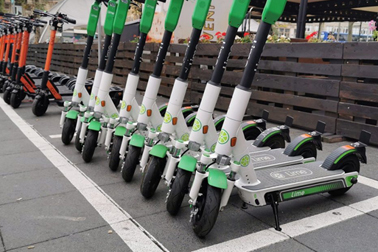Issue 164 - October 2025
RE: MEMBERS

Authority Members Lead Regional Efforts on E-Bike Safety
In response to community concerns over the safety and regulation of electric bicycles and similar mobility devices, the cities of Hermosa Beach, Westlake Village, Azusa, and San Clemente have enacted ordinances aimed at curbing unsafe riding behavior in public spaces. Riding on city streets remains permitted, and mobility aids recognized under the Americans with Disabilities Act are exempt from this restriction.
The City of Westlake Village’s ordinance bans e-bikes, electric scooters, and other recreational electric mobility devices from sidewalks, parks, trails, fields, and drainage basins within city limits. Hermosa Beach’s ordinance requires all e-bike riders under the age of 18 to wear helmets, and all passengers must have their own seats. The City of Azusa’s ordinance prohibits the use of e-bikes and motorized scooters in parks, on sidewalks, and in city recreational and government facilities. San Clemente’s ordinance prohibits dangerous riding, including traveling with passengers on an e-bike and performing stunts like wheelies. San Clemente’s new e-bike rules hold parents equally responsible for violations committed by their children, including any fines.
The ordinances come amid a regional uptick in complaints about reckless riding, particularly by minors. According to Westlake Village City Manager Rob de Geus, the affordability and popularity of high-powered electric vehicles have outpaced local governments’ ability to regulate their use. “Electric vehicles, especially e-bikes and e-motorcycles, can reach speeds of over 40 miles per hour, creating a safety hazard for pedestrians and parkgoers,” de Geus noted in a memo to the Westlake Village City Council.
The ordinances empower law enforcement officers to administer the new rules. Additionally, some of the agencies’ ordinances carry escalating fines ranging from $100 to $1,000.
Westlake Village’s ordinance extends sections of the California Vehicle Code, such as those addressing speeding and reckless driving, to all public properties and private lots open to the public, provided appropriate signage is in place.
As other municipalities across Southern California grapple with similar challenges, these agencies’ proactive approach may serve as a model for balancing mobility innovation with public safety.
Building on this momentum, it is equally important for municipalities to adopt a comprehensive strategy that addresses all forms of cycling, not just e-bikes. While much attention has been placed on minors operating high-powered electric bikes, other cyclists, such as those training for races or riding at high speeds, can also pose safety risks when they disregard traffic laws and ride aggressively in shared public spaces. A balanced approach that incorporates education, enforcement, and clearly defined expectations for all riders, regardless of their equipment or experience level, is essential to promoting safer streets and protecting pedestrians, parkgoers, and fellow cyclists alike.
To support these efforts, the California JPIA encourages member agencies to stay informed on developments in e-bike regulation and evaluate how local ordinances and enforcement strategies can be leveraged to mitigate risk and enhance community well-being.
< Back to Full Issue Print Article
